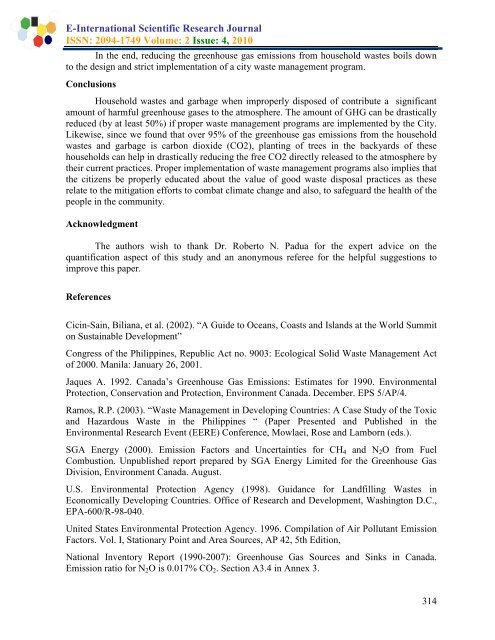download the full article here - EISRJC
download the full article here - EISRJC
download the full article here - EISRJC
Create successful ePaper yourself
Turn your PDF publications into a flip-book with our unique Google optimized e-Paper software.
E-International Scientific Research JournalISSN: 2094-1749 Volume: 2 Issue: 4, 2010In <strong>the</strong> end, reducing <strong>the</strong> greenhouse gas emissions from household wastes boils downto <strong>the</strong> design and strict implementation of a city waste management program.ConclusionsHousehold wastes and garbage when improperly disposed of contribute a significantamount of harmful greenhouse gases to <strong>the</strong> atmosp<strong>here</strong>. The amount of GHG can be drasticallyreduced (by at least 50%) if proper waste management programs are implemented by <strong>the</strong> City.Likewise, since we found that over 95% of <strong>the</strong> greenhouse gas emissions from <strong>the</strong> householdwastes and garbage is carbon dioxide (CO2), planting of trees in <strong>the</strong> backyards of <strong>the</strong>sehouseholds can help in drastically reducing <strong>the</strong> free CO2 directly released to <strong>the</strong> atmosp<strong>here</strong> by<strong>the</strong>ir current practices. Proper implementation of waste management programs also implies that<strong>the</strong> citizens be properly educated about <strong>the</strong> value of good waste disposal practices as <strong>the</strong>serelate to <strong>the</strong> mitigation efforts to combat climate change and also, to safeguard <strong>the</strong> health of <strong>the</strong>people in <strong>the</strong> community.AcknowledgmentThe authors wish to thank Dr. Roberto N. Padua for <strong>the</strong> expert advice on <strong>the</strong>quantification aspect of this study and an anonymous referee for <strong>the</strong> helpful suggestions toimprove this paper.ReferencesCicin-Sain, Biliana, et al. (2002). “A Guide to Oceans, Coasts and Islands at <strong>the</strong> World Summiton Sustainable Development”Congress of <strong>the</strong> Philippines, Republic Act no. 9003: Ecological Solid Waste Management Actof 2000. Manila: January 26, 2001.Jaques A. 1992. Canada’s Greenhouse Gas Emissions: Estimates for 1990. EnvironmentalProtection, Conservation and Protection, Environment Canada. December. EPS 5/AP/4.Ramos, R.P. (2003). “Waste Management in Developing Countries: A Case Study of <strong>the</strong> Toxicand Hazardous Waste in <strong>the</strong> Philippines “ (Paper Presented and Published in <strong>the</strong>Environmental Research Event (EERE) Conference, Mowlaei, Rose and Lamborn (eds.).SGA Energy (2000). Emission Factors and Uncertainties for CH 4 and N 2 O from FuelCombustion. Unpublished report prepared by SGA Energy Limited for <strong>the</strong> Greenhouse GasDivision, Environment Canada. August.U.S. Environmental Protection Agency (1998). Guidance for Landfilling Wastes inEconomically Developing Countries. Office of Research and Development, Washington D.C.,EPA-600/R-98-040.United States Environmental Protection Agency. 1996. Compilation of Air Pollutant EmissionFactors. Vol. I, Stationary Point and Area Sources, AP 42, 5th Edition,National Inventory Report (1990-2007): Greenhouse Gas Sources and Sinks in Canada.Emission ratio for N 2 O is 0.017% CO 2 . Section A3.4 in Annex 3.314
















